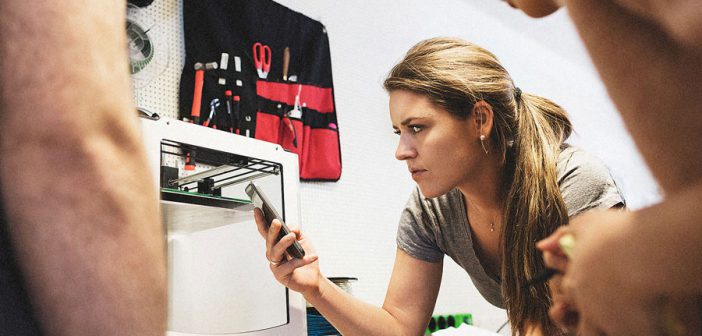Here’s why, and how to build the right one for your company.
It’s one thing to say you want a culture of innovation. It’s another to actually get everyone truly innovating. We hear it all the time from the executive suite—take more risks, embrace uncertainty, learn from failure.
The problem is that these mandates don’t necessarily move the needle. In fact, if they become seen as leadership lip service, they can actually lower morale and stifle the very innovation you want most.
So what can you do? You can start by building an innovation tool kit.

[Photo: ArthurHidden/iStock]
SET SMALL, MEDIUM, AND LARGE INNOVATION GOALS
It’s no secret the business world has become enamored by “disruptive” innovation. Everyone wants to be the next Apple, Uber, or Airbnb. Nothing wrong with that.
But if we only swing for the fences, we won’t score on singles, doubles, or triples. And the reality of business is that moderate changes are just as important as the sporadic home run.
For example, CSAA Insurance Group, one of the insurance companies associated with the American Automobile Association, uses three types of innovation to help its 3,800 employees understand their role in fostering a culture of innovation. The approach includes making explicit distinctions between different types of innovation, from incremental to disruptive. Leadership realistically expects that the vast majority of the company’s innovation will smaller tweaks that advance the core business. It’s perfectly okay that most people—from call center employees to claims adjusters in the field—focus on continuous improvements to current business processes, the customer experience, and insurance products.
While CSAA Insurance Group also focuses on “major advancements” (e.g., creating new digital customer experiences) and “disruptive innovation” (e.g., exploring the insurance implications of self-driving cars) as part of its innovation strategy, fewer overall resources are allotted to these larger efforts. Taking a portfolio view of innovation while having the vast majority of people striving to improve the business every day is the goal.
Recognizing that innovation comes in different sizes—incremental improvements, major advancements, and big disruptions—helps demystify the whole concept of innovation so it applies to each and every employee, no matter his or her role or function.

[Photo: Jacob Ammentorp Lund/iStock]
ROVIDE TOOLS OF THE INNOVATION TRADE
Telling employees to “go forth and innovate” isn’t enough. With the premise that everyone has an equal opportunity to add innovation-based value, it’s essential to help jump-start the process. Many organizations provide innovation tool kits to promote and foster innovation across business units and functions.
Most innovation tool kits these days have roots in design thinking, and draw inspiration from one of the original freely available tool kits from the Stanford Design School called the Bootcamp Bootleg. Silicon Valley’s iconic software firms, Intuit and Adobe, were two of the first to deliver design thinking tool kits based on Stanford’s approach to their broader employee populations. And both Intuit and Adobe have made their tool kits available to the public to download as part of their commitment to advancing the field of innovation.
Intuit’s Catalyst Toolkit outlines a three-step “design for delight” process that begins with gaining empathy for customers’ problems, brainstorming solutions, and testing and refining ideas in partnership with real customers. Intuit’s product teams use the tool kit to enhance software features for the likes of TurboTax and QuickBooks. But the tools have also been applied internally to create things like the “Techknow Bar,” which emulates the Apple Store’s Genius Bar by providing a walk-up support desk where any employee can get instant IT help any time.
Adobe’s tool kit is named Kickbox and actually comes packaged in a snazzy red box and outlines a more comprehensive process. Perhaps the most surprising thing in the box is a standard $1,000 gift card. Those receiving a Kickbox don’t spend the cash on themselves. They use it to develop prototypes and test ideas through placing online ads that promote nonexistent products while measuring click-through response rates as a gauge of customer interest.
Some progressive government organizations aren’t far behind the tech industry. The Australian government created the Public Sector Innovation Toolkit that includes a comprehensive suite of methodologies for reinventing public sector processes, customer experiences, and government services. The government promotes and reinforces its tools through its Innovation Showcase Awards.
For example, last year an innovation in “energy ratings labels” received widespread recognition across Australia. For more than two decades, Australian consumers visited appliance showrooms and could compare energy-efficiency ratings by viewing stickers on refrigerators, washers, dryers, computers, and other products. With the rise of web-based retailers, energy consumption information was often missing from online product descriptions. An Energy Rating Team developed and implemented a suite of digital icons that have now become the energy rating standard across Australia’s online retailers. Online stores now display icons that provide important information on a specific product’s relative energy efficiency.
Tool kits can also be implemented on a smaller scale. The Colorado Department of Education recognized the need to promote community engagement to help advance education across its state. To support its school districts, a Community Collaboration for School Innovation Toolkit was developed to help educators bring “the voice of the customer” (parents, employers, community organizations, etc.) into educational planning and curriculum development. One early win occurred in Grand Junction, Colorado, where the tool kit helped engage the local community in developing the school district’s next generation graduation guidelines—a blueprint for the requisite knowledge and skills the district’s graduates need to be successful in the 21st century.
DON’T THROW IT OVER THE WALL
Creating a culture of innovation involves more than just making a tool kit available on the corporate intranet. True culture change requires direct engagement. The goal is to catalyze a broader culture of innovation where every person feels the itch to add a new level of value to whatever they’re doing. Sometimes people need to see and experience something before they’re willing or able to dive in themselves.
CSAA Insurance Group, for example, recently embarked on an effort to help all employees learn to use their own innovation tool kit. Employees and managers, many of whom are on intact teams, jointly roll up their sleeves in a half-day format focused on solving a real business problem. Not only do they generate ideas, they collectively identify the business challenges that demand the focus of their innovation efforts for the next year, which helps sustain momentum following the workshop since people walk out of the session aligned around what to go do and how. The event is much more than training. It’s a real innovation session that demonstrates the tangible power of the innovation process while instilling new skill sets across the company.
Similarly, there’s a small catch to obtaining Adobe’s Kickbox (and the $1,000 gift card). To get the Kickbox, employees must sign up for a workshop that includes training in Adobe’s six-step innovation process. Providing some type of hands-on workshop or training helps people viscerally experience the creative process and encourages them to join the organization’s movement in creating a culture of innovation.

[Photo: Rawpixel Ltd/iStock]
6 STEPS TO INNOVATION TOOL KIT SUCCESS
There are many tool kits and innovation processes out there. All of them share various features, usually include an innovation model, involve a step-by-step process, and provide specific templates that support each step. Most organizations can easily adapt and customize the various “open sourced” tool kits out there, whether from Stanford Design School, Intuit, Adobe, CSAA Insurance Group, or others. Whatever the specific tools, here’s what to consider when creating and introducing an innovation tool kit to support your broader innovation culture efforts:
1. Take the best and reinvent the rest—find an existing open-sourced tool kit and modify it to fit the language and innovation process of your own organization.
2. Build the innovation brand—give your tool kit a compelling name and design a brand image that resonates with people, just like Intuit named their tool kit Catalyst and Adobe created Kickbox.
3. Rally people around real problems—provide people with opportunities like workshops and hackathons to try out the tool kit, apply it to a real challenge or opportunity, and learn to use it in a “safe” environment.
4. Tap the energy of early adopters—identify the people who get most excited by innovation overall, and see the tool kit as a way to express their creative spirit. Track their progress using the tool kit and recruit them to help others to see and experience the value by facilitating workshops and training sessions.
5. Relish in the early wins—consistently communicate small, medium, and large success stories to help the broader organization see the value of the tool kit and internalize that innovation is desired and valued.
6. Get out of the way—provide the time and space for individual contributors and teams to use (and even modify) the innovation tool kit in whatever way helps them achieve their current and future goals.
As with anything, some people will dive in and others will remain on the sidelines until the tool kit proves itself to be more than an organizational fad. Leadership’s number one mandate should focus on highlighting how the tool kit is just one component—albeit an important one—of a broader organizational effort focused on driving a culture of innovation. Ultimately, a tool kit’s success can be measured by how ingrained it becomes as a symbol and accepted approach for innovation across the organization—and, of course, what business results flow from it.
Creating a culture of innovation is an inherently ambiguous process. When done right, an organization’s innovation tool kit and culture can become the “invisible advantage” that leads to a continuous stream of incremental improvements, major advancements, and if you’re lucky, even a disruptive innovation.
Featured Photo: Maskot/Getty Images
This article first appeared in www.fastcodesign.com



